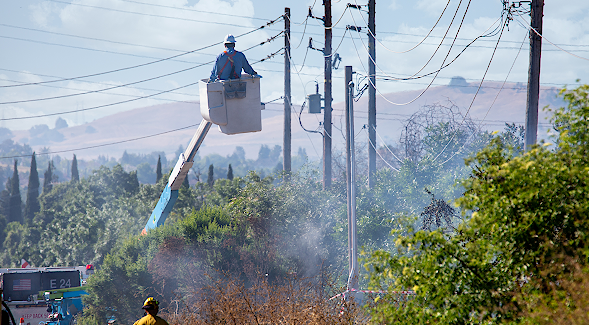Preventing Wildfires Sparked by Power Lines
Q&A with engineer Saeed Manshadi, whose team uses artificial intelligence to calculate fire risk and help utilities decide when to shut off power.

Hot, dry conditions paired with high winds can lead to devastating wildfires. Southern California’s famous Santa Ana winds, for example, can down power lines, which in turn have ignited some of the most extensive fires in the state, according to research funded by the U.S. Geological Survey.
In response, utilities monitor weather forecasts and implement public safety power shutoffs to reduce the risk of wildfire ignitions due to power line failures.
San Diego State University assistant professor of electrical and computer engineering Saeed Manshadi recently received a grant from the National Science Foundation to study how to improve electrical grid resilience in fire-prone areas. SDSU NewsCenter’s Susanne Clara Bard asked Manshadi how utilities calculate fire risk when making power shutoff decisions, and how that process can be improved.
How do power lines ignite wildfires during extreme weather conditions and how much of a threat is this to towns, cities and natural areas?
There are several potential ways in which power lines can cause wildfire ignitions. Dry conditions and excessive heat make any spark a potential risk. A sustained wind gust might cause debris to touch multiple conductors, leading to a short circuit fault, with the current passing through the fault creating hot particles. This is more of a significant issue in rural areas where power lines are overhead conductors, while in vulnerable urban areas, they are mainly undergrounded, which practically eliminates the wildfire risk. In addition, an aging power line infrastructure is spread across the countryside over dried vegetation. In fact, the Oregon Department of Forestry reported that line undergrounding led to substantial declines in ignitions. However, this is not a practical solution in all circumstances due to land use limits, and because it requires expensive investments in low-population areas.
How do public safety public safety power shutoffs help prevent wildfire ignitions during extreme weather events and how do utilities calculate when to shut the power off?
Public utility commissions across the world allow utilities to exercise public safety power shutoffs to avoid wildfire risk. Once power is off, there is no energy on the line, therefore there is no spark even if debris touches power lines. The golden question is to quantify the risk so well that it’s only done when it is absolutely necessary. Many areas under risk are also under excessive heat with elevated electricity demand, so it is not an easy decision to make.
Utilities employ various technologies ranging from remote video surveillance to high-end meteorological weather stations to gather information on several factors, including wind gusts, which are a key indicator. This approach is quite challenging in complicated terrain with a lot of microclimates, and it requires a large number of data collection points. Once collected, the data is overlaid on the electrical infrastructure to determine the risk to individual components. And because the network in rural areas has fewer customers, it has fewer remote control switches — which means a risk for a small part of the network requires a large area to be shut off.
Your team recently published a paper in IEEE Systems Journal outlining ways to improve the shutoff decision-making process using artificial intelligence. Explain how this could help prevent wildfires.
We proposed a surrogate model — which is like a digital twin for the meteorological conditions experienced by the power infrastructure. We gather limited meteorological measurements along with infrastructure structural parameters to quantify the risk for each line. This model explicitly pinpoints the at-risk components by feeding these quantitative measures into a balancing mechanism that targets public safety power shutoffs to those areas where it’s absolutely necessary, while maintaining maximum possible energy supply when the total and local wildfire risk is below a certain threshold.
It will be at the discretion of the system operator to pick that threshold. In practice, the risk cannot be eliminated to an absolute zero even with vast blanket power shutoffs. But long-term measures to those communities that are occasionally impacted by these events would require unprecedented investment using traditional solutions like undergrounding.
Our new NSF project aims to address this challenge with smarter solutions. Our AI-enabled surrogate model for impacted communities would first quantify the risk and then deploy the next generation of energy resources like local solar and battery storage, along with targeted public safety power shut-offs to keep the broader community safe. This would be a more reliable, resilient and efficient solution given other risk factors — such as earthquakes — in areas like California. Our approach would also enhance social equity, as rural populations in hot areas are disproportionately impacted by the power shutoffs when they need to stay cool.
The most efficient and effective solution to electrification and decarbonization challenges is not necessarily visible even by the naked eye of experts. It requires artificial intelligence techniques like the one we propose in this project to reveal new insights and unlock new possibilities. Our team is dedicated to developing new, innovative solutions to modern energy needs given the legitimate environmental concerns over carbon emissions in the face of extreme weather events that make it hard for an aging infrastructure to deliver to consumers.



